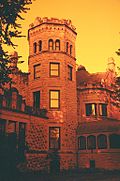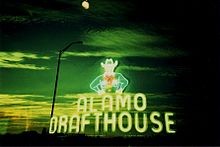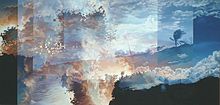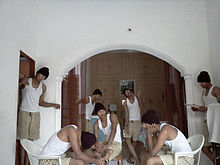- Multiple exposure
-
"Double exposure" redirects here. For other uses, see Double exposure (disambiguation).
Alternative photography Bleach bypass · Cross processing · Fisheye · HDR · Holga · Infrared · Lomography · Multiple exposure · Pinhole · Polaroid art · Redscale · Solarisation · Through the Viewfinder
In photography, a multiple exposure is the superimposition of two or more individual exposures to create a single photograph. The exposure values may or may not be identical to each other.
Contents
Overview
Ordinarily, cameras have a sensitivity to light that is a function of time. For example, a one second exposure is an exposure in which the camera image is equally responsive to light over the exposure time of one second. The criterion for determining that something is a double exposure is that the sensitivity goes up and then back down. The simplest example of a multiple exposure is a double exposure without flash, i.e. two partial exposures are made and then combined into one complete exposure. Some single exposures, such as "flash and blur" use a combination of electronic flash and ambient exposure. This effect can be approximated by a Dirac delta measure (flash) and a constant finite rectangular window, in combination. For example, a sensitivity window comprising a Dirac comb combined with a rectangular pulse, is considered a multiple exposure, even though the sensitivity never goes to zero during the exposure.
Double exposure
Analogue
In film and photography, double exposure is a technique in which a piece of film is exposed twice, to two different images. The resulting photographic image shows the second image superimposed over the first. The technique can be used to create ghostly images or to add people and objects to a scene that were not originally there. It is frequently used in photographic hoaxes. It also is sometimes used as an artistic visual effect, especially when filming singers or musicians.
It is considered easiest to have a manual winding camera for double exposures. On automatic winding cameras, as soon as a picture is taken the film is typically wound to the next frame. Some more advanced automatic winding cameras have the option for multiple exposures but it must be set before making each exposure. Manual winding cameras with a multiple exposure feature can be set to double-expose after making the first exposure.
Since shooting multiple exposures will expose the same frame multiple times, negative exposure compensation must first be set to avoid overexposure. For example, to expose the frame twice with correct exposure, a −1 EV compensation have to be done, and −2 EV for exposing four times. This may not be necessary when photographing a lit subject in two (or more) different positions against a perfectly dark background, as the background area will be essentially unexposed.
Medium to low light is ideal for double exposures. A tripod may not be necessary if combining different scenes in one shot. In some conditions, for example, recording the whole progress of a lunar eclipse in multiple exposures, a stable tripod is essential.
More than two exposures can be combined, with care not to overexpose the film.
Ian Hornak. Title: Hannah Tillich's Mirror: Rembrandt's Three Trees Transformed Into The Expulsion From Eden, acrylic on canvas, 60 x 120 inches, 1978. An example of multiple as applied to fine art.
Digital
Digital photographs can be superimposed by using a software photo editor such as Adobe Photoshop or GIMP, by altering the opacity of the two images and line them up over each other, or set the layers to multiply mode, which 'adds' the colors together rather than making the colors of either image pale and translucent.
Examples in art, movies and television
- On the Ed Sullivan Show, this effect was sometimes used with singers and rock groups. An image of the stage set was superimposed on the performer(s).
- In the movie Mary Poppins, when Julie Andrews is singing "Feed the Birds" to the children, there's an instrumental section of the song. During this section, an image of St. Paul's Cathedral is superimposed on Julie Andrews' face.
- On the 1960s situation comedy The Dick Van Dyke Show, there's a special Christmas episode called "The Alan Brady Show Presents". On that episode, the double exposure effect is used on Larry Mathews (who played Dick Van Dyke and Mary Tyler Moore's cute young son, Ritchie). He's singing the Christmas song "Little Drummer Boy", and at one point, an image of the stage set (a stained glass window) is superimposed on his face.
- On a current commercial for Fruit of the Loom underwear, this effect is used. In this commercial, the "Fruit of the Loom" men are a pop music group (with the "Apple" as the lead singer), and they're performing a ballad about a little boy who loves his "Fruit of the Loom" underwear.
- At the beginning of an episode of the popular '70's action series Wonder Woman, the double exposure effect is used on Lynda Carter (Wonder Woman). An outer-space style background (i.e. black sky, stars and lights) is superimposed on an image of her face and shoulders.
- From 1970 until 1985 fine artist, Ian Hornak created a series of 'multiple exposure landscape paintings'. The artist would capture multiple exposure photographs and then project them onto canvas. While the image was projected, he would sketch it with pencil and finally execute the painting using acrylic paint.
C.E.M.E.N.T.
With electronic imaging, long duration sensitivity is not practical, so multiple exposures are usually made using CEMENT (Computer Enhanced Multiple Exposure Numerical Technique). This simulates the effect of multiple exposures numerically, by using a computer, or computation.[citation needed]
The use of CEMENT as a medium of artistic expression dates back to the 1970s and early 1980s with the invention of the wearable computer as a tool for visual artists.[citation needed]
Long exposures
With traditional film cameras, a long exposure is a single exposure, whereas with electronic cameras a long exposure can be obtained by integrating together many exposures. This averaging also permits there to be a time-windowing function, such as a Gaussian, that weights time periods near the center of the exposure time more strongly. Another possibility for synthesizing long exposure from multiple-exposure is to use an exponential decay in which the current frame has the strongest weight, and previous frames are faded out with a sliding exponential window.
Scanning film with multiple exposure
Multiple exposure technique can also be used when scanning transparencies like slides, film or negatives using a film scanner for increasing dynamic range. With multiple exposure the original gets scanned several times with different exposure intensities. An overexposed scan lights the shadow areas of the image and enables the scanner to capture more image information here. In contrary an underexposed scans allows to gather more details in the light areas. Afterwards the data can be calculated into a single HDR image with increased dynamic range.
Among the scanning software solutions which implement multiple exposure are VueScan and SilverFast.
See also
References
External links
- Examples of using CEMENT
- How to multiple expose with an APS camera
- How to multiple expose with any 35mm camera
- Digital noise reduction by double exposure
Categories:- Photographic techniques
Wikimedia Foundation. 2010.








